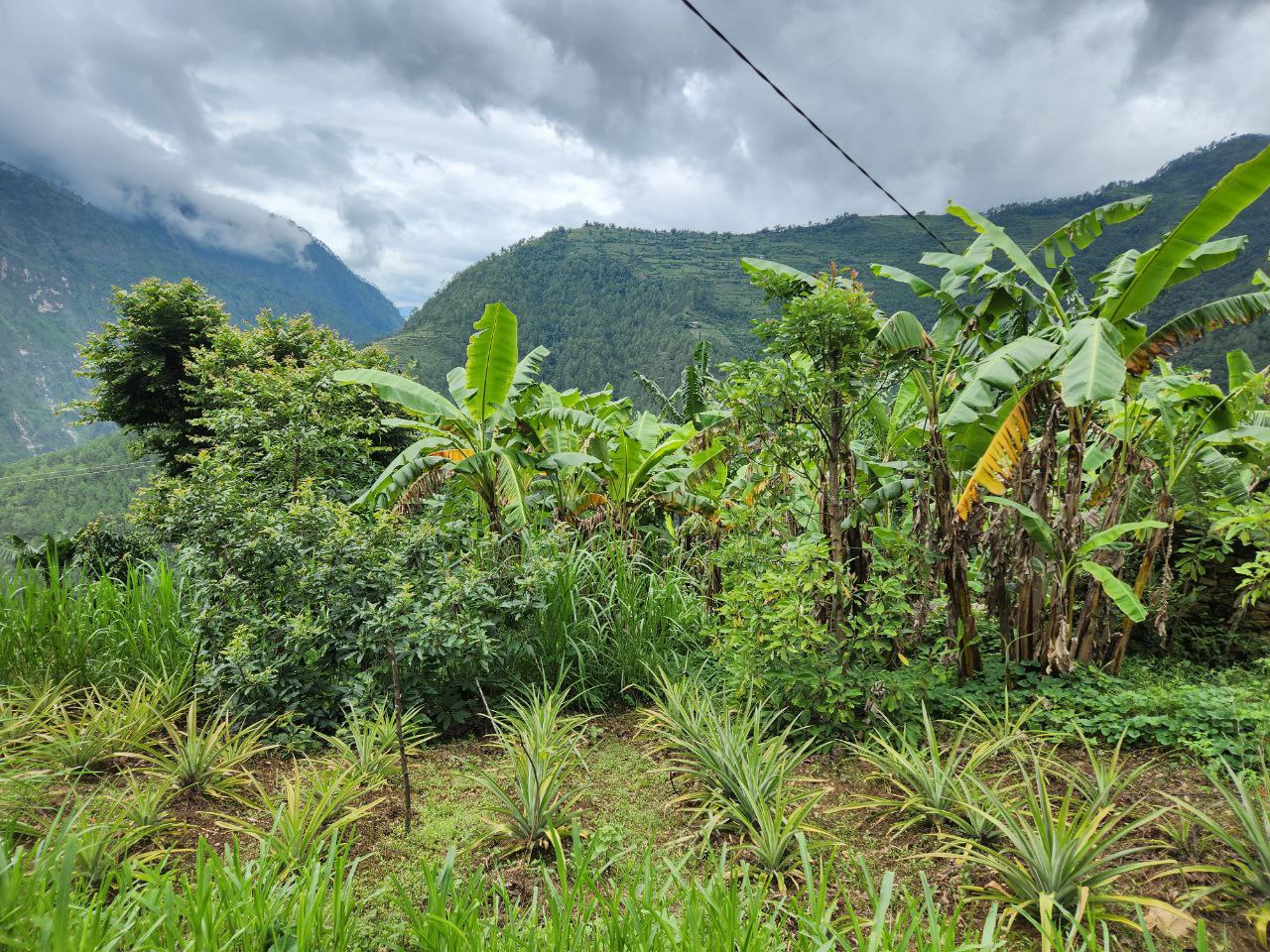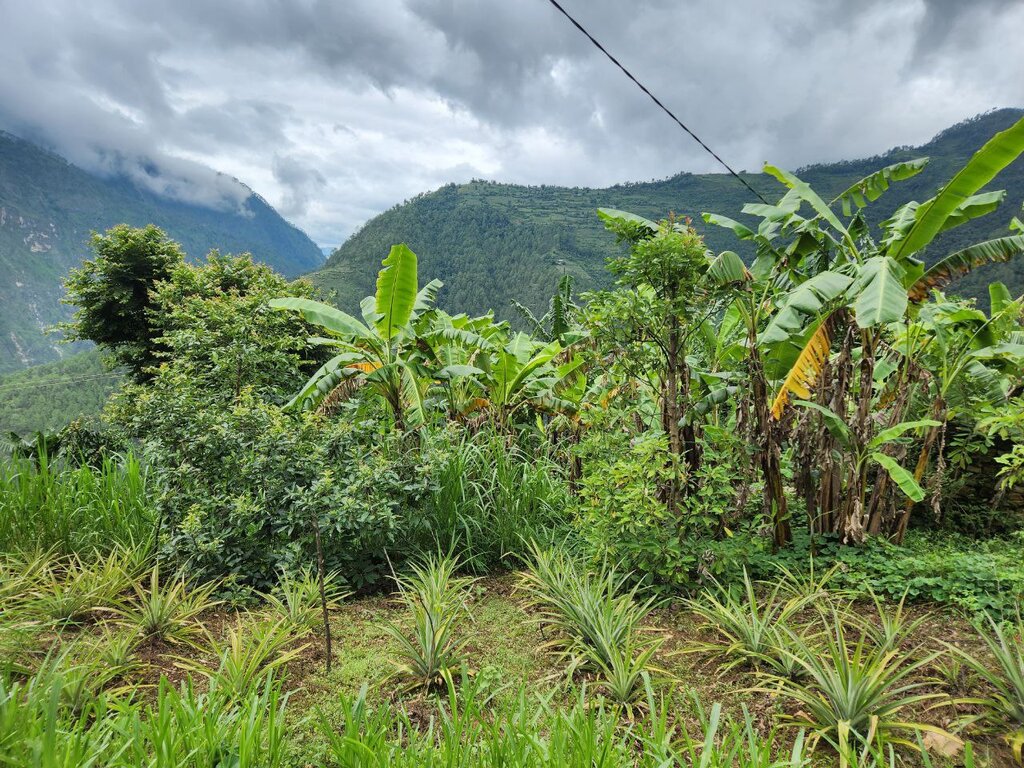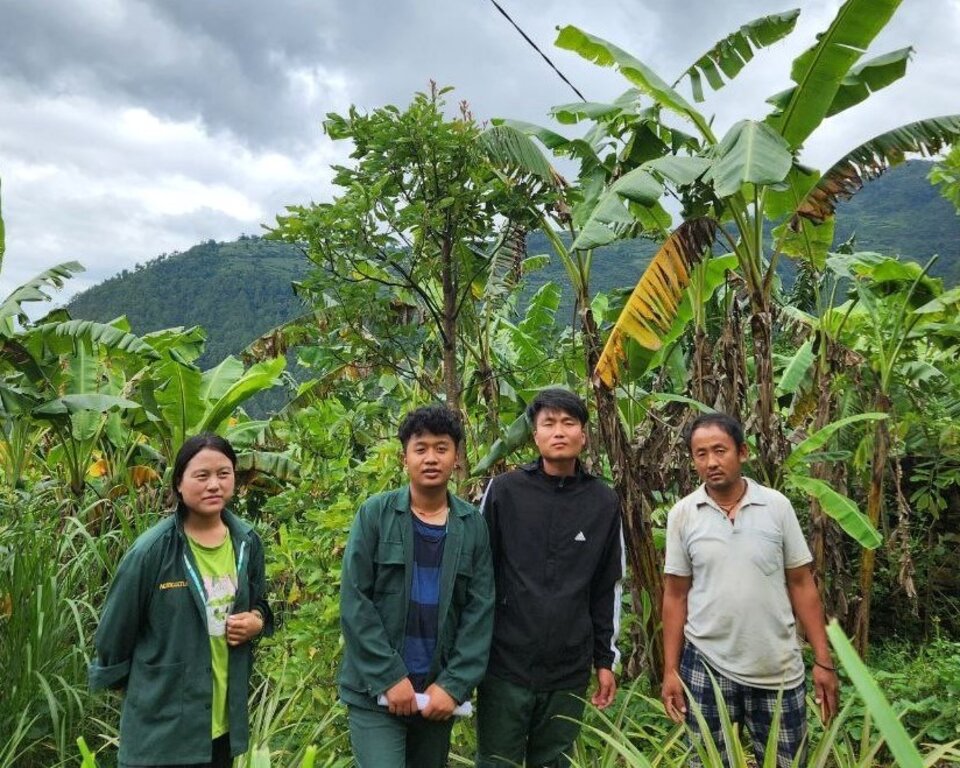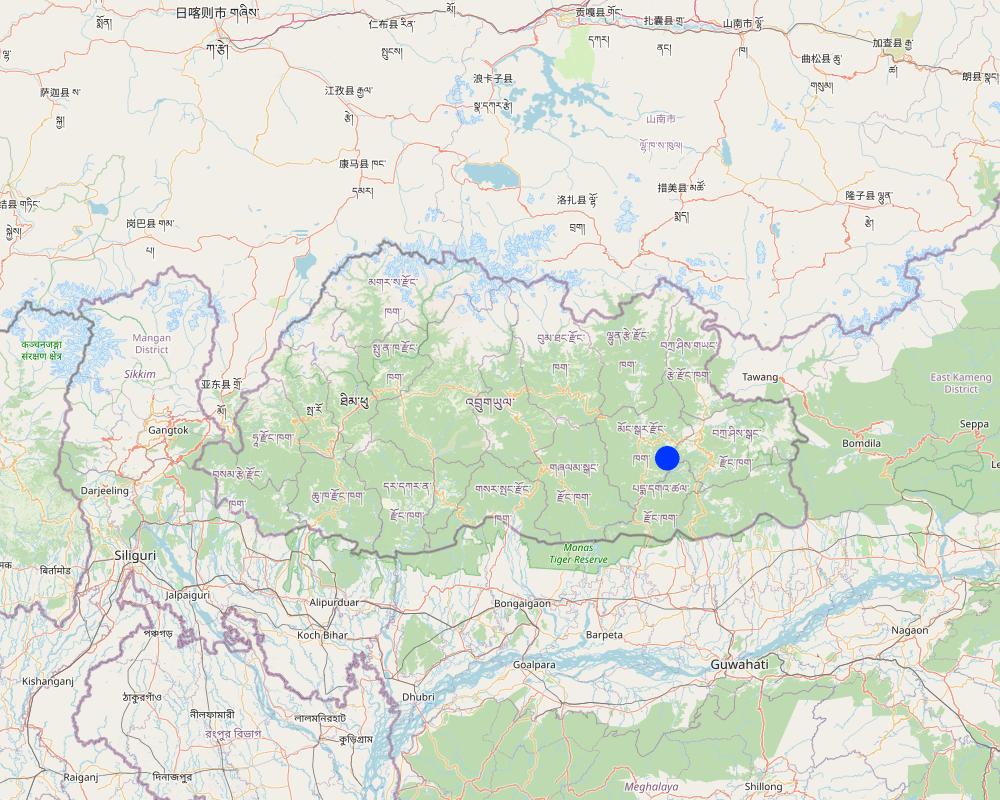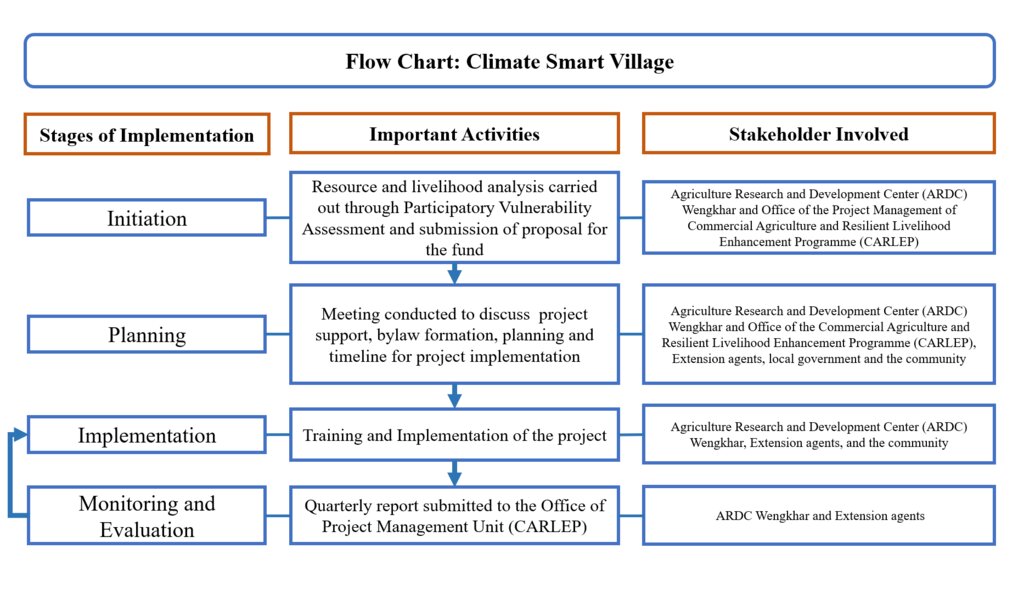Climate-Smart Village Approach [不丹]
- 创建:
- 更新:
- 编制者: ONGPO LEPCHA
- 编辑者: –
- 审查者: William Critchley, Rima Mekdaschi Studer
གནམ་གཤིས་ཐབས་ལམ་གྱི་གཡུས།
approaches_6852 - 不丹
查看章节
全部展开 全部收起1. 一般信息
1.2 参与方法评估和文件编制的资源人员和机构的联系方式
关键资源人员
土地使用者:
Yangki Karma
77211775
Ngaru-Pongtang village
Ngaru-Pongtang village, Thangrong gewog (block), Mongar Dzongkhag (district), Bhutan
不丹
土地使用者:
Lhaden Sanga
77625788
Ngaru-Pongtang village
Ngaru-Pongtang village, Thangrong gewog, Mongar Dzongkhag, Bhutan
不丹
土地使用者:
Lhendup
17526138
Ngaru-Pongtang village
Ngaru-Pongtang village, Thangrong gewog, Mongar Dzongkhag, Bhutan
不丹
有助于对方法进行记录/评估的项目名称(如相关)
Strengthening national-level institutional and professional capacities of country Parties towards enhanced UNCCD monitoring and reporting – GEF 7 EA Umbrella II (GEF 7 UNCCD Enabling Activities_Umbrella II)有助于对方法进行记录/评估的机构名称(如相关)
National Soil Services Centre, Department of Agriculture, Ministry of Agriculture & Livestock (NSSC) - 不丹1.3 关于使用通过WOCAT记录的数据的条件
(现场)数据是什么时候汇编的?:
15/07/2023
编制者和关键资源人员接受有关使用通过WOCAT记录数据的条件。:
是
2. SLM方法的描述
2.1 该方法的简要说明
Climate change has become inevitable, and there is a need to address this impending danger. In the Climate-Smart Village (CSV) approach, land users in Ngaru-Pongtang have implemented several technologies and innovations to address climate change impacts, and the programme has worked with 50 households on a total area of 137 acres (55 ha).
2.2 该方法的详细说明
该方法的详细说明:
This approach focused on transforming Ngaru-Pontang into a Climate-Smart Village (CSV) with actions that also contribute to mitigating climate change. The programme has worked with 50 households on a total area of 137 acres (55 ha). The approach included a participatory vulnerability assessment, and extensive training and education for the land users. They were equipped with skills, technologies, and innovative practices related to climate-smart agriculture (CSA). Additionally, the approach emphasized collaborative efforts, working closely with community members to foster better engagement and cooperation.
The primary objectives of the approach were to transform Ngaru-Pontang village into a CSV and thus effectively address the challenges posed by climate change. To achieve these goals, the approach employed various methods. It involved meetings with the community members, vulnerability assessment, fostering collaboration between the community, Agriculture Research and Development Centre (ARDC) Wengkhar, and Commercial Agriculture and the Resilient Livelihood Enhancement Programme (CARLEP). The community members received comprehensive training and attended workshops on climate-smart agriculture practices.
The implementation of the approach adopted the following stages:
1. Resource and livelihood analysis carried out through a Participatory Vulnerability Assessment.
2. Based on the findings from the above assessment, a project proposal was submitted to secure funding.
3. Subsequently, discussions were held with the community members, the extension agent, and the local government to ensure collective agreement and support.
4. A detailed plan with a timeline was developed to guide project implementation and monitoring.
5. Training and workshops on CSA practices were conducted by the ARDC and the extension agent, empowering the community members to take charge of project implementation and ensure sustainability.
Key stakeholders involved in the approach included:
1. ARDC Wenkhar, which led the implementation of the project, facilitated the training and workshops, provided technical assistance, and monitored the programme's progress.
2. The Gewog administration and the extension agent played crucial roles by offering support and assistance in implementing climate-smart agriculture practices in the field.
3. The community members actively participated in various program activities, playing a pivotal role in driving the project forward.
4. The Commercial Agriculture and Resilient Livelihood Enhancement Programme (CARLEP) acted as the funding agency.
The key CSA practices implemented through this approach are soil fertility improvement technologies (composting through use of FYM and bio-slurry, vermicomposting; liquid manure, biochar, Bhutan Agri-Microbial Solution (BAMS) and hedgerow plantations), community solar-electric fencing, heat and drought tolerant crops (spring paddy, soybean, avocados, mangoes and pineapples), biogas installations and establishment of weather station.
The implementation of CSA interventions has resulted in a wide range of impacts on livelihoods, income, and enhanced climate resilience. The diversification of crops, electric fencing, and improvement in irrigation have enabled farmers to expand their cultivation area thereby directly enhancing crop production and cash income. Similarly, the integration of improved livestock farming systems along with crops and the installation of biogas plants have reduced impacts on natural resources. Farmers have gained knowledge and exposure to different climate-smart agriculture practices. The only negative impact of the measures has been extra damage to crops by wild animals.
2.3 该方法的照片
2.5 采用该方法的国家/地区/地点
国家:
不丹
区域/州/省:
Mongar Dzongkhag
有关地点的进一步说明:
Ngaru-Pongtang village, Thangrong gewog
Map
×2.6 该方法的开始和终止日期
注明开始年份:
2016
终止年份(若不再采用该方法):
2021
注释:
The establishment of the CSV was between 2016 to 2021, but activities continue to progress despite the completion of the project.
2.7 方法的类型
- 基于项目/方案
2.8 该方法的主要目的/目标
The main objective of the approach was to establish Ngaru-Pongtang as a CSV and showcase different CSA practices geared towards combating, mitigating and addressing climate change impacts, which can be replicated to other gewogs and Dzongkhags.
2.9 推动或妨碍实施本办法所适用的技术的条件
财务资源和服务的可用性/可得性
- 启动
Community members were provided with equipment and planting materials through project's support.
机构设置
- 启动
Local government and gewog agriculture extension agent were involved during the training, seminars and the implementation of the project activities to ensure ownership and sustainability of the project.
参与者的的协作/协调
- 启动
Stakeholders (ARDC Wengkhar, local government and community members) participated and cooperated together during the entire project period.
了解SLM,获得技术支持
- 启动
ARDC Wengkhar provided regular training and workshops with regard to climate-smart agriculture, good agricultural practices and sustainable land management for the successful implementation of the project.
市场(购买投入,销售产品)和价格
- 启动
ARDC Wengkhar has facilitated agricultural marketing by linking up the community with Bhutan Agro-Industry located at Lingmethang, Mongar.
3. 相关利益相关者的参与和角色
3.1 该方法涉及的利益相关者及其职责
- 当地土地使用者/当地社区
Ngaru-Pongtang community
As a beneficiary, participated actively in the planning and implementation of the project activities, ensuring the project was successful and beneficial to them.
- 研究人员
ARDC Wenkhar
Led the implementation of the project; facilitated the training and the workshops; provided technical assistance to the program; and monitored the progress of the program.
- 地方政府
Gewog administration and gewog agriculture office
They provided administrative support and collaborated with other stakeholders in successful designing and implementation of the project activities.
- 国际组织
International Fund for Agricultural Development (IFAD)
IFAD provided financial assistance through its Commercial Agriculture and Resilient Livelihood Enhancement Programme (CARLEP)
3.2 当地土地使用者/当地社区参与该方法的不同阶段
| 当地土地使用者/当地社区的参与 | 指定参与人员并描述活动 | |
|---|---|---|
| 启动/动机 | 被动 | The local community members were informed verbally and through community meeting about the project. |
| 计划 | 互动 | ARDC Wengkhar, Thangrong gewog administration, gewog agriculture extension agent and the community members came together and discussed the way forward for the project. |
| 实施 | 互动 | Community members were provided with training and workshops on climate-smart agriculture and related agricultural skills. After the training and demonstrations, land users were divided into groups and made to apply these skills in their field. |
| 监测/评估 | 互动 | Monitoring is being sporadically conducted by ARDC Wengkhar and the gewog agriculture extension agent, but it is left to the land users to monitor their own fields. |
3.3 流程图(如可用)
具体说明:
The flowchart was created based on the information provided by the community members
作者:
Ongpo Lepcha
3.4 有关SLM技术选择的决策
具体说明谁有权决定选择要实施的技术:
- 主要是SLM专家,咨询土地使用者之后
解释:
ARDC Wenkhar was responsible for deciding on what technologies and innovations to apply in the community, however, this was done based on consultation and discussions with the community members of Ngaru-Pongtang.
明确做出决策的依据:
- 对充分记录的SLM知识进行评估(基于证据的决策)
- Consultation with the community members
4. 技术支持、能力建设和知识管理
4.1 能力建设/培训
是否为土地使用者/其他利益相关者提供培训?:
是
明确受训人员:
- 土地使用者
如果相关,请说明性别、年龄、地位、种族等。:
Both males and females were trained.
培训形式:
- 农民对农民
- 示范区域
- 公开会议
涵盖的主题:
The topics covered included climate-smart agriculture, sustainable land management, and good agricultural practices.
注释:
The capacity building was conducted by the Agriculture Research Development Center (ARDC) in Wengkhar and the participants included community members. The program was coordinated, facilitated, and implemented by an extension agent in collaboration with Local Government and beneficiaries.
4.2 咨询服务
土地使用者有权使用咨询服务吗?:
是
指明是否提供了咨询服务:
- 在土地使用者的土地上
说明/注释:
ARDC Wengkhar and the agricultural extension agent provided all the technical advice and assistance required by the community members.
4.3 机构强化(组织发展)
是否通过这种方法建立或加强了机构?:
- 是,适度
具体说明机构的强化或建立程度:
- 本地
说明机构、角色和职责、成员等。:
The local government was involved in the project from start till end, which enhanced their understanding and capacity to initiate and replicate similar projects in other villages.
具体说明支持类型:
- 能力建设/培训
- Technical assistance
提供进一步细节:
Local government officials were engaged in the capacity building programs implemented for the community and also provided technical assistance as and when required.
4.4 监测和评估
监测和评估是该方法的一部分吗?:
是
注释:
ARDC Wenkhar and the agriculture extension agent sporadically conducted monitoring and evaluation. However, the local land users are given the full responsibility to monitor their own fields and seek assistance when required.
若是,该文件是否用于监测和评估?:
否
4.5 研究
研究是该方法的一部分吗?
是
- Vulnerability Assessment
提供进一步的细节,并指出是谁做的研究:
ARDC Wengkhar conducted a resource and livelihoods analysis through vulnerability assessment before designing and implementng the project in the community.
5. 融资和外部物质支持
5.1 该方法中SLM组成部分的年度预算
说明该方法中SLM部分的年度预算,单位为美元:
55920.82
注释(例如主要的资助来源/主要捐助者):
The funding was through Commercial Agriculture and Resilient Livelihoods Enhancement Programme (CARLEP) funded by International Fund for Agricultural Development (IFAD).
5.2 为土地使用者提供财政/物质支援
土地使用者是否获得实施该技术的财政/物质支持?:
是
如果是,请具体说明支持的类型、条件和提供者:
Material inputs such as seeds and seedlings, organic fertilizers, sprinkler pipes, and green shade net were provided through the project.
5.3 对特定投入的补贴(包括劳动力)
- 设备
| 具体说明哪些投入得到了补贴 | 程度如何 | 对补贴做出具体说明 |
|---|---|---|
| 机械 | 部分融资 | Sprinkler pipes and green shade nets |
- 农业
| 具体说明哪些投入得到了补贴 | 程度如何 | 对补贴做出具体说明 |
|---|---|---|
| 种子 | 充分融资 | Seeds and saplings |
| 化肥 | 充分融资 | Organic fertilizers |
如果土地使用者的劳动力是一项重要的投入,那么是不是:
- 自愿
注释:
The project beneficiaries arranged their own family labour or through informal labour exchange model.
5.4 信用
是否根据SLM活动的方法给予信用值?:
否
5.5 其它激励或手段
是否有其他激励措施或工具用于促进SLM技术的实施?:
否
6. 影响分析和结论性陈述
6.1 方法的影响
该方法是否有助于当地土地使用者,提高利益相关者的参与度?:
- 否
- 是,很少
- 是,中等
- 是,支持力度很大
The project built capacity of the land users and are able to implement and monitor project activities in their own fields.
该方法是否帮助土地使用者实施和维护SLM技术?:
- 否
- 是,很少
- 是,中等
- 是,支持力度很大
Conducting training and workshops were part of the approach and therefore this made implementing and maintaining the sustainability of the project possible.
该方法是否提高了土地使用者实施土地管理的知识和能力?:
- 否
- 是,很少
- 是,中等
- 是,支持力度很大
The training and workshop helped provide knowledge and skills regarding sustainable land management and climate smart agriculture practices.
该方法是否提高了其他利益相关者的知识和能力?:
- 否
- 是,很少
- 是,中等
- 是,支持力度很大
The project enabled local government to enhance their knowledge and capacity through direct engagement in the training program and in the implementation of the project activities in the field.
该方法是否有助于社会和经济弱势群体?:
- 否
- 是,很少
- 是,中等
- 是,支持力度很大
The project benefited all the community members equally disregarding of their background.
该方法是否改善了粮食安全/改善了营养?:
- 否
- 是,很少
- 是,中等
- 是,支持力度很大
The climate-smart agriculture practices have improved the agricultural production through crop diversification, electric fencing and irrigation water improvement.
该方法是否改善了市场准入?:
- 否
- 是,很少
- 是,中等
- 是,支持力度很大
ARDC Wengkhar and the local government have facilitated the market by linking the community with Bhutan Agro-industry for processing.
该方法是否提高了土地使用者适应气候变化/极端情况和减轻气候相关灾害的能力?:
- 否
- 是,很少
- 是,中等
- 是,支持力度很大
Land users were trained on climate-smart agriculture and most importantly the land users have implemented climate smart agriculture practices in their fields which will definitely help build their capacity to adapt to the climate change.
6.2 土地使用者实施SLM的主要动机
- 增加生产
The diversification of crops (drought resistant crop varieties), improvement of irrigation water and electric fencing have helped to expand cultivation and enhance production.
- 增加利润(能力),提高成本效益比
Facilitation of market linkage wth Bhutan Agro-Industry has provided assured market for the local produce.
- 提高SLM知识和技能
The community members have been trained on SLM and CSA practices.
- Adapt and mitigate climate change
CSA practices including SLM has minimised soil erosion, increased soil organic matter, conserved soil moisture and improved the overall soil health.
6.3 方法活动的可持续性
土地使用者能否维持通过该方法实施的措施(无外部支持的情况下)?:
- 是
若是,请说明如何维持:
The land users have built their capacity, improved their production and cash income which should enable them to sustain the project activities.
6.4 该方法的长处/优点
| 土地使用者眼中的长处/优势/机会 |
|---|
| Capacity building and technical assistance on CSA and SLM were provided. |
| Gained knowledge and skills on CSA practices |
| Were able to increase crop production through CSA interventions |
| Were provided with an assured market for their produce |
| 编制者或其他关键资源人员认为的长处/优势/机会 |
|---|
| Built human and natural capital through capacity building and implementation of CSA practices. |
| Enhanced community resilience to climate change impacts |
6.5 该方法的弱点/缺点以及克服它们的方法
| 土地使用者认为的弱点/缺点/风险 | 如何克服它们? |
|---|---|
| The approach didn't address the pest problem, specifically the vertebrate pest adequately. | Explore additional funding to support electric fencing and if possible chain link fencing. |
| Farmers' hesitance to adopt technology. | Create adequate awareness prior to actual design an implementation of the project. |
7. 参考和链接
7.1 方法/信息来源
- 与土地使用者的访谈
3 individuals
7.2 参考可用出版物
标题、作者、年份、ISBN:
Saanogo, D, Sail, M., & Camara, B. A.. (2020). The climate-smart village approach: putting communities at the heart of restoration. Tropenbos International, Wageningen.
可以从哪里获得?成本如何?
https://www.tropenbos.org/file.php/2385/etfrn-news-60-sanogo-the-climate-smart-village-approach.pdf
标题、作者、年份、ISBN:
Aggarwal, P. K., Jarvis, A., Campbell, B. M., & Zougmore, R. (2018). The climate-smart village approach: Framework of an integrative strategy for scaling up adaptation options in agriculture. Ecology and Society, 23(1).
可以从哪里获得?成本如何?
https://www.researchgate.net/publication/322765373_The_climate-smart_village_approach_Framework_of_an_integrative_strategy_for_scaling_up_adaptation_options_in_agriculture
7.3 链接到网络上可用的相关信息
标题/说明:
The climate smart villages approach
URL:
https://www.grida.no/resources/4928
标题/说明:
THE CLIMATE-SMART VILLAGE APPROACH: FRAMEWORK OF AN INTEGRATIVE STRATEGY FOR SCALING UP ADAPTATION OPTIONS IN AGRICULTURE
URL:
https://ccafs.cgiar.org/resources/publications/climate-smart-village-approach-framework-integrative-strategy-scaling
链接和模块
全部展开 全部收起链接
无链接
模块
无模块


